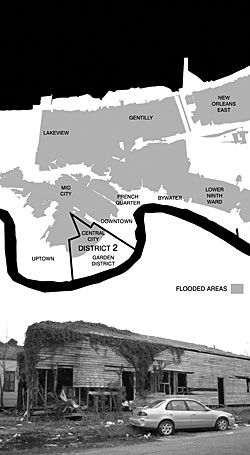The French Quarter, the Garden District, the Treme, the Lower Ninth Ward. Perhaps more than any other American city, New Orleans is a collection of individual neighborhoods — 72 in all — each with its own history and culture.
In many ways, these neighborhoods represent both the key and the key challenge to rebuilding the city, says John Hoal, Ph.D., associate professor of architecture in the Sam Fox School of Design & Visual Arts at Washington University in St. Louis.

Last week, Hoal’s firm, H3 Studio Inc., was one of five selected to lead the Unified New Orleans Plan, which will coordinate rebuilding in the city’s 13 planning districts. Another 10 firms, including St. Louis-based HOK, will generate plans at the neighborhood level.
“The challenge is to rebuild these very distinct neighborhoods in ways that recognize their very particular heritages,” Hoal explains. “You can’t just formulate a generic proposal.
“New Orleans has fabulous architecture, but New Orleans is really about a kind of spirit,” Hoal continues. “The individual will to rebuild homes is simply amazing. Our challenge is to craft a plan that accommodates the character of each area while also recognizing the rebuilding people have already done.”
Hoal spent most of the summer developing H3 Studio’s proposal and made a formal community presentation Aug. 1. Final selections were announced Aug. 28, marking the one-year anniversary of Mayor Ray Nagin’s mandatory evacuation order.
H3 Studio, which was selected from a field of 65 nationally and international firms, will have primary responsibility for planning in District 2 and District 13.
District 2 — split almost equally between high ground and low ground — is a pie-shaped area wedged between downtown and uptown along the Mississippi River. It is probably best known for the historic Garden District, home to a famously well-preserved collection of Southern mansions. Other areas include the working class Irish Channel and the predominantly African-American Central City neighborhood, the latter of which sustained significant flood damage.
District 13 is located across the river on the Mississippi’s west bank, on a large swath of land formed by a sharp bend in the river. Predominantly a conservation area, it includes the lower- to middle-income communities of New Aurora as well as the suburban English Turn area (home to a Jack Nicklaus-designed golf course), the English Turn Wilderness Park and the Audubon Nature Institute’s Center for Research of Endangered Species.
“We have a real cross-section,” Hoal points out. “Historic homes, low-density conservation areas, places that were blighted even before Katrina. Some were completely decimated by flooding, others stayed dry but sustained substantial wind damage. It’s really stunning.”
For example, while the Irish Channel and Garden District largely escaped flooding, portions of Milan and Central City were inundated and the latter was also hard-hit by post-Katrina crime.
Still, Hoal is optimistic.
“The other side to the devastation is the incredible display of will,” he says. “For all the hardship, people are moving back, gutting their houses and rebuilding. We need to tap into that spirit as part of the planning process.
Engaging refugees in other cities
“Another component is Diaspora outreach,” Hoal adds. “We’ll be traveling to other cities, such as Houston, Dallas and Atlanta, which have absorbed significant numbers of New Orleans refugees. We need to engage them in the planning process at the same time we’re working with people already on the ground.”
“A major engineering failure tied to natural disaster — from an urban design perspective, that’s an incredibly important lesson,” Hoal explains. “What do you do next? What is the role of design? How do you address the needs of people whose lives have been wiped out from under them?
“These are important questions that need to be debated and addressed.”
Project manager for H3 Studio will be Derek Hoeferlin, affiliate assistant professor of architecture in the Sam Fox School, who lived and worked in New Orleans for more than 10 years, predominantly in District 2. The team also includes alumni Jessica Garz (BA ’06), Laura Lyon (M.Arch. 00) and Bryan Taylor Robinson (M.Arch. 04) as well as current graduate student Peter Elsbeck.
Hoal and Hoeferlin will also teach a pair of traveling studios in New Orleans, Hoal for the Sam Fox School’s Master of Urban Design program, Hoeferlin for the undergraduate College of Architecture. Both studios follow the school’s recent participation in CITYbuild, a nationwide consortium of university-based design-build programs that has been active in the area.
Last semester Hoeferlin led the Sam Fox School’s first traveling undergraduate studio to New Orleans. Working at both urban and architectural scales, the studio focused on prototype housing and urban revitalization for the Central City neighborhood.
The Unified New Orleans Plan was initiated by the New Orleans Community Support Foundation in cooperation with the mayor’s office, the City Council and the City Planning Commission. The goal is to present a comprehensive, citywide recovery plan to the Louisiana Recovery Authority by early 2007. Following a ratification process, the recovery plan will be used to guide both the investment of federal funds and the strategic rebuilding of communities throughout Orleans Parish.
Funding for the Unified New Orleans Plan is provided by donations from the Greater New Orleans Foundation and the Rockefeller Foundation, among many others.
Hoal, prior to forming H3 Studio, co-founded and served as director for the City of St. Louis’ first Urban Design Department. Major projects include the $110 Forest Park Master Plan, which rebuilt much of the historic park’s crumbling infrastructure, and St. Louis’ $1.4 billion Downtown Development Action Plan.